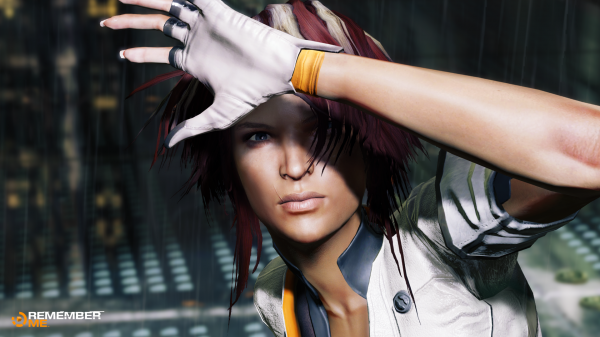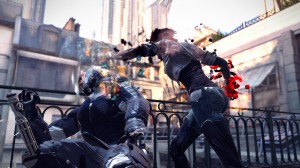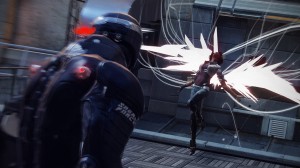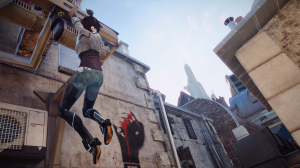Remember Me Review (360)
- Updated: 3rd Jun, 2013

Remember Me’s world is a fascinating place. Set in a New-Paris of 2084, everyone sports a SenSen implant, a device that exports memories and allows you to trade full sensory experiences. This world is also full of valet bots that do everything from carrying shopping to cleaning windows to repairs about the house. In fact, manufacturing these bots has become so cheap that humans do barely anything any more. You have the occasional doctor or researcher but the vast majority seem to sit in cafés enjoying the Parisian sunshine, or cheer themselves up by purchasing a happy memory from a nearby vending machine.
Nilin is our protagonist, a cart-wheeling, hacker-glove wielding ass-kicker with no personality and a tendency to do whatever she’s told by the voice in her ear that calls himself Edge. That’s probably understandable though, since she’s just had most of her memory ripped out, been broken out of prison and is public enemy number one. Lacking anything better to do, Nilin and I follow what the voice tells us, shimmying up pipes and leaping from platform to platform to pursue Bad People and grab interesting tidbits from their heads.
Neo-Paris, 2084
The world that developers Dontnod Entertainment have created is fascinating. The sci-fi exploration of what happens when someone else controls your memories is thought-provoking and the environments, filled with valet robots toiling away at menial jobs, are impressive. The characters, not so much. Remember Me feels like a game that was much more ambitious than it was ever allowed to be.
Early in the game you’ll meet Headache Tommy and Olga Sedova, in the first and only scene where Nilin seems like a human being and not agent of destruction. It’s here that you have the first Memory Remix sequence, a series of puzzles where you delve into someone’s head and change their memory by hacking into glitches in the recording. It seems that in this world, changing a single memory gives people an entire personality transplant and has the knock-on effect of altering every single memory in their head (or external storage device) that followed on from that moment. At least, that’s the only interpretation that makes sense.
Conveniently, real-world events never seem to remind any of Nilin’s victims that actually, they know their friend didn’t die 20 years ago because they ran into her in the street a week after the supposed death occurred. The game does take place over the course of a day, so you could argue that the chances of finding conflicting information are slim, but it does feel like a missed trick. It doesn’t help that Nilin’s overly-earnest internal monologue makes the events of this morning seem like a lifetime ago.
Much of the storytelling is like this – initially promising but what could be the most interesting aspects are relegated to background and collectible entries. This could’ve been a real exploration into the consequences of corporate-controlled thoughts but instead, Remember Me takes the safer, more typically game-like route. Even Nilin’s relationship with Edge never actually warms into real conversation.
Memory Remix
The memory remix sections are beautifully detailed and I did enjoy watching scenarios play out as I tweaked a trophy here or a cigarette there. The controls themselves are tedious though, and if you pick too many red herrings early in the challenge, it quickly becomes a slog of undoing changes, making changes and undoing more changes, all the while having to twizzle your analogue stick in circles to simulate winding a VCR. We have digital video now, let’s get better interfaces. These sections would have been massively improved if each glitch could be activated or deactivated from a menu after it was found.
There are other puzzles as well – a few rotating platform challenges, and even a sequence of riddles that you have to ponder through for yourself (or Google if you’re feeling lazy and not playing it pre-release). I always appreciate having to think in a game, even if the solutions themselves only require a few minutes of mulling. The guard drones, however, are some of the worst guards I’ve ever seen. Each patrols a few square metres of corridor and every single one of them has a blind spot in the form of a corner nook or a convenient pillar, or can even just be followed around their patrol cycle in plain sight.
Killing Things
The combo lab is a strange puzzle unto itself that weaves its way throughout the game. Where most melée games like DmC unlock a series of moves and predetermined combos, Remember Me gives you four pre-determined movesets and allows you to decide what each of those sets achieves. Over the course of the story, you’ll unlock “pressens”, basically X or Y commands that do one of four things:
- Damage an enemy
- Heal Nilin
- Reduce the cooldown of a power
- Extend the previous move
You get to decide what order you want to put the pressens, within your fixed movesets. Pressens placed later in the set are more powerful, so there’s a trade-off between power and convenience. Here’s a combo lab demo video that may help to clarify things.
 When fighting an enemy that requires your special powers, maybe you’ll want to front-load a combo with heals in order to put the cooldowns in the more powerful positions at the back and help you grind up “focus” to access these powers. Or perhaps you know you’ll get interrupted a lot, so placing the key pressens at the end of a long combo will be too risky. I found this customisation immensely practical, switching things up to compensate for different battle types. It was less practical in the times where I’d gear up for one type of enemy and be besieged by a completely different group.
When fighting an enemy that requires your special powers, maybe you’ll want to front-load a combo with heals in order to put the cooldowns in the more powerful positions at the back and help you grind up “focus” to access these powers. Or perhaps you know you’ll get interrupted a lot, so placing the key pressens at the end of a long combo will be too risky. I found this customisation immensely practical, switching things up to compensate for different battle types. It was less practical in the times where I’d gear up for one type of enemy and be besieged by a completely different group.
Checkpoints in this game are probably the best I’ve ever seen. You rarely lose more than a minute’s progress, and that includes multi-part battles. As a result of this however, when you’re geared up for the wrong type of enemy, dying means that you need to re-jig your combos over and over again each time. It’s also encouraged the designers to pop in the occasional insta-death moment unless you know what’s coming, which is never a fun experience (Playdead’s exceptional Limbo notwithstanding).
I like the combat system’s design, but the implementation itself feels clunky. Nilin’s fight animations aren’t tied to the pressens, so you’re reliant on the display at the bottom of the screen to tell you what move she’s doing and whether your next button-push has registered. This – combined with the awful camera that locks onto whatever it damn well chooses – makes it awkward to pull off combos while avoiding incoming attacks in large-scale battles.
 It’s compensated for by Nilin’s special focus-driven powers (known as S-pressens) but, if anything, these are overpowered or at least underchallenged. Fury, for example switches you from battle combos into a literal button-bashing mode as Nilin bounces around from enemy to enemy while you furiously mash X and Y with little rhyme or reason. Another power lets you sneak around and insta-kill almost any enemy. Like much of the game, they’re visually stunning and incredibly stylised, but this reduces the harder battles to grind-fests for focus, robbing you of any real sense of satisfaction.
It’s compensated for by Nilin’s special focus-driven powers (known as S-pressens) but, if anything, these are overpowered or at least underchallenged. Fury, for example switches you from battle combos into a literal button-bashing mode as Nilin bounces around from enemy to enemy while you furiously mash X and Y with little rhyme or reason. Another power lets you sneak around and insta-kill almost any enemy. Like much of the game, they’re visually stunning and incredibly stylised, but this reduces the harder battles to grind-fests for focus, robbing you of any real sense of satisfaction.
Freedom
Remember Me is a completely linear game, almost to the point of frustration. Much like 2010’s Enslaved, the camera would much rather show you a beautiful view and point you in the right direction than let you explore for yourself. Given that the world is full of collectibles, it’s odd to find yourself jumping off-camera because you’re sure you saw something shiny, but these are rarely more than a few metres’ diversion. Valid landing points are flagged with HUD markers, also like Enslaved, so you’ll generally know when you’re on the right track. However, I did find myself frequently battling the camera just to search for an item.
 Very helpfully, once you’ve finished, you have the option to replay the story with all your standard pressens unlocked, though the S-pressens are confined to their story mode locations. Even after starting a new replay, you can jump between completed episodes to pick up the collectibles you missed.
Very helpfully, once you’ve finished, you have the option to replay the story with all your standard pressens unlocked, though the S-pressens are confined to their story mode locations. Even after starting a new replay, you can jump between completed episodes to pick up the collectibles you missed.
The cutscenes are unskippable, however, as are the swooping camera shots which shock and awe the first-time visitor but now just stop you running to where you want to be. As with much of the game, Dontnod come so close to user-friendly brilliance, but with a fundamental design flaw.
Thanks to the spectacular world though, and the ambitious concepts, I enjoyed the game enough to look past the problem. It’s more “Baby’s First Melee Game” than a competitor to DmC or Bayonetta, which is just about right for me. Go check it out and remember me to Neo-Paris.



Follow Us!